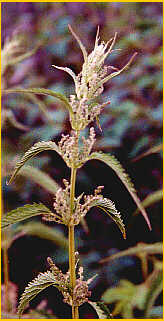British Columbia Outdoor Wilderness Guide  |

- Stinging
Nettle
(Urtica dioica)
The
Stinging Nettle is a stinging perennial that grows
up to 3 metres in height from spreading rhizomes.
- LEAVES:
- -
The leaves of the Stinging Nettle grow on
opposite sides of the stem
- -
from slender spears to much rounder and elliptical
- -
jagged deeply toothed
- -
up to 15 mm. long
- FLOWERS:
- -
Stinging Nettle flowers are tiny and numerous
- -
greenish in colour
- -
have no petals
- -
hang in drooping clusters where the leaves
join the main stalk
- -
the male and female flowers are in separate
clusters with the female usually higher
- FRUIT:
- -
1 seeded, dry, flattened and nut-like
- HABITAT:
- -
Stinging Nettle grows in low to subalpine
elevations
- -
Stinging Nettle usually grows in groups
- -
very abundant
- -
prefer a damp, rich soil
- -
Stinging Nettle appears in disturbed areas;
natural such as avalanche tracks or man-made
such as barnyards or roadsides
- -
open woods and meadows
- FASCINATING
FACTS:
- -
formic acid is secreted from the broken hollow
hairs causing a skin rash
- -
fresh, young Stinging Nettle leaves can be
cooked and eaten
- -
an infusion of the leaves is used by herbalists
as an additive to a natural hair rinse and
for skin problems
- -
a tea made from Stinging Nettle roots and
leaves was used for internal problems with
the kidney, liver, bladder as well as to treat
diabetes
- -
nettles have been used for years as a 'spring
tonic'
- -
Where Stinging Nettles are found, it is usually
possible to find plantain nearby. The green
juice extracted from the plantain by crushing
(or chewing and mixing with saliva), when
rubbed on the affected area of the skin is
known to quickly ease the discomfort of stinging
nettles or mosquito bites
-
|
|

